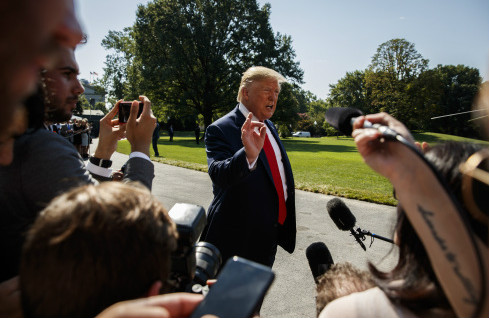For the few remaining terms, the Trump administration still seems to miss Iran.
After a series of recent increased accusations and sanctions, U.S. Secretary of State Pompeo called Iran an umbrella for Al-Qaeda on the 12th, which was immediately refuted by Iranian Foreign Minister Zarif.
What’s more interesting is that there were many signs that the Trump administration may suddenly launch a military strike on Iran at the last minute of its term. Now, the current U.S. administration only has one last week in its term. Does the possibility of the United States use force against Iran still exist?
In an interview with the First Financial Reporter, Sun Degang, a researcher at the Institute of International Studies of Fudan University, said that Pompeo’s speech was largely gestures, and Trump is now trapped in internal affairs and there is little time left. The possibility of the Trump administration launching a military operation against Iran at the last minute is already very low.
Force deterrence is increased layer by layer
The Trump administration enters the countdown to the Trump administration after Biden wins the U.S. election. Therefore, the Trump administration and U.S. regional allies seize this precious “window period” and increase pressure on Iran, which is seen as “diging holes” for the next U.S. government to return to the Iran nuclear agreement.
U.S. President Trump announced the dismissal of Defense Secretary Esper on November 9, 2020. Esper was kicked out of the government in the final stage because he disagreed with Trump on many issues. Since then, several U.S. Defense Department officials have anonymously revealed to the media that Trump is likely to “launch operations” against Iran or other opponents in the “last days of his term”.
And Trump asked senior advisers whether he could take action against Iran’s main nuclear facilities in the next few weeks at a meeting in the White House office on November 12, 2020, further confirming the statement of Defense officials.
On the afternoon of November 27, 2020, Iran’s chief nuclear scientist Fahrizad was killed in an attack on the outskirts of the capital Tehran. Since then, the United States has increased its military activities around Iran.
On January 3, the U.S. Department of Defense changed its idea of withdrawing the aircraft carrier Nimitz and ordered the aircraft carrier to continue to be deployed in the Middle East to deal with the so-called “recent threat posed by Iran”. Previously, on December 21, the U.S. Navy also revealed that a nuclear-powered submarine of the United States Navy crossed the Strait of Hormuz and sailed into the Persian Gulf.
On January 7, two nuclear-carrying B-52 bombers left the military base in the United States for 36 consecutive hours before returning to the Persian Gulf. This is the fourth mission carried out by B-52 bombers around Iran since November 21 last year. On the same day, the U.S. military issued a statement saying: “The U.S. military has sent a clear message of deterrence by demonstrating its ability to deploy overwhelming combat forces in a short period of time.”
The military intimidation of the United States has lasted for many months. Iran did not sit idly by and watched. On January 9, Iran held a naval exercise in the Persian Gulf, after a large-scale joint drone exercise, demonstrating the latest national defense achievements and military strength.
It is believed that several Iranian exercises are aimed at warning the enemy that Iran has the ability to monitor and ensure the security of its territory and related maritime areas, and is ready to deal with enemy threats.
Changes after the riots in the United States
On January 6, some demonstrators supporting Trump’s overthrow of the presidential election forced their way into the U.S. Capitol, interrupting the voting process of the Senate and the House of Representatives Accredited Electoral College. The riots killed five people. In view of Trump’s responsibility for this incident, the U.S. House of Representatives is expected to hold a plenary vote on the presidential impeachment on the 13th.
On January 7, Iranian Foreign Minister Zarif tweeted: “It is disturbing that this person (Trump) also has unlimited nuclear strike powers, which is at stake in the security of the entire international community.”
On this issue, Zarif thought of joining Pelosi, Speaker of the U.S. House of Representatives. Pelosi said that after Congress fell, she immediately talked on the phone with General Millie, chairman of the U.S. Military Association of Participation, to discuss “existing preventive measures to prevent an unstable president from launching military war, or contacting nuclear codes and ordering nuclear strikes”.
Pelosi revealed that Milly assured her that measures were being taken to prevent Trump from ordering a nuclear attack. The President of the United States, as the commander-in-chief of the U.S. military, is the only person who has the right to use nuclear weapons without the authorization of Congress.
In an interview with First Financial Reporter, Sun Degang said that the previous general judgment was that Trump would use his last time in office to take some limited military actions against Iran to send a “gift” to allies in Israel, Saudi Arabia and other regions.
He analyzed that now, in the short time left, Trump will be bound by internal affairs and have no time to take care of him. At the same time, the U.S. Congress is preventing Trump from using his authority to suppress his indiscriminate force in a stronger manner.” Trump is basically waiting (to step down) now, and it is difficult to take any more substantive measures.” Sun Degang said.



